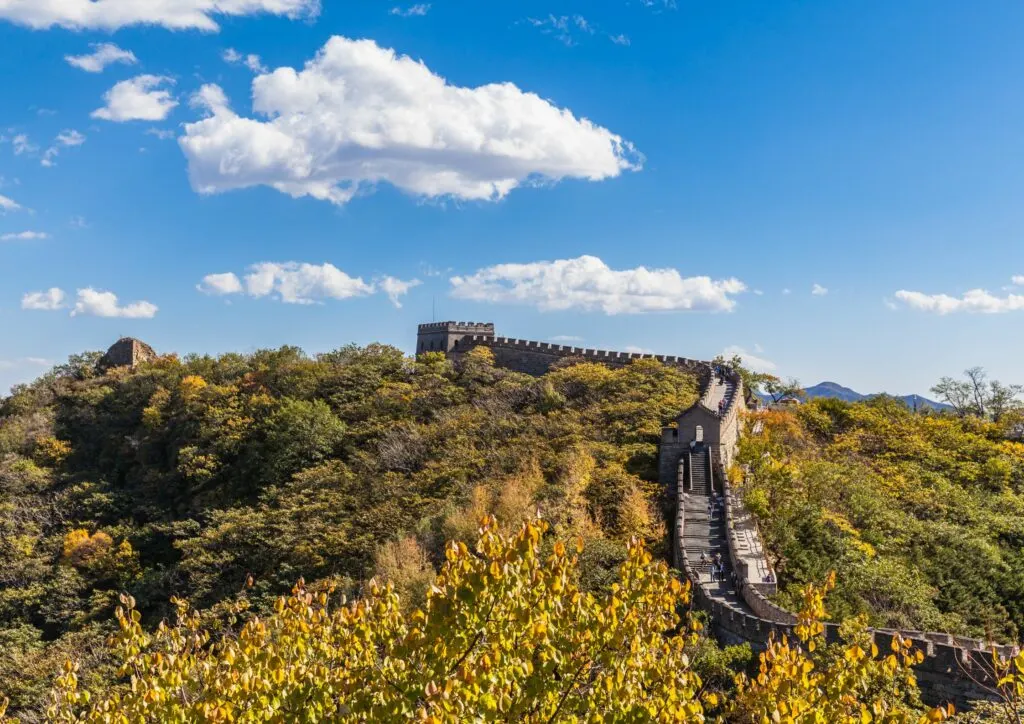Even if you live under a rock (literally – if you are Patrick Star) there’s no way you wouldn’t have heard of the Great Wall of China. Needless to say, this is no ordinary ancient wall – it is one of the most time-withstanding structures that continue to bewitch those who visit and read about it.
We set on a journey unlike any we’ve taken to see for ourselves what made it a world wonder.
Let’s start with how it all began.
The History – Where it all began
Brick by brick, layer by layer – the great wall initially began to take shape under the charge of 3 warring states to protect themselves from many forms of nomadic raids (476 – 221 BC).
When the 1st Emperor of China – Emperor Qin Shi Huang, united the states, the construction of the great wall re-started with the aim of protecting the country from invasions from other borders.
Under the Han Dynasty, the wall grew even longer (extending from Dunhuang to the Bohai Sea).
During the Ming Dynasty, under the charge of General Qi Jiguang, the wall was rebuilt better and stronger till it fell into decay during the Qing Dynasty and underwent further repairs under the rule of Mao Zedong in 1957.
The wall was rumoured to have been used for military training later on but drawing up to current times, the Great Wall underwent a few more reforms to ensure it remained a cultural symbol of China.
It was even granted UNESCO World Heritage site status in 1987.
Reaching the Great Wall

The most visited and popular sections of this 21,196 km long wall are Mutianyu, Badaling, Juyonguan, Jinshanling and Simatai.
We chose to visit the Wall at Mutianyu – as our research showed higher recommendations for this particular section (we were not disappointed with our choice either).
We started in Beijing. It was a 73 km journey. You can take a taxi (It’s a little on the pricey end) or take a bus service. Unfortunately, there is no direct train route so that might not be the first choice for many travellers.
In 2 hours, we were in Mutianyu. We arrived as early as possible, and since it wasn’t a public holiday or a weekend, the crowd was generally less. You really begin to appreciate this fact when waiting at the ticket window to get your tickets.
Note – the ticket stations only accept cash and if you couldn’t bring any with you, there are plenty of ATM machines nearby.
You have the choice of choosing between the Chair lift or the cable car to get to the wall. You’ll see families with elderly and small kids taking the cable car – we decided to use the cable car – which seats six adults per ride.
Before reaching the cable car station, we did explore the nearby tourist village – here you can buy some snacks and beverages and maybe a souvenir or two before heading off to the base (via a shuttle bus).
Once you step out, you can enjoy a little scenic walk to the cable car station, by this time you are already at a certain elevation and the verdant sceneries before you can be very distracting. Just take a moment to enjoy the view around you before setting off.
Obviously, it’s exciting, and since the cars are moving at a regulated speed, you can absorb everything around you and enjoy the lovely natural scenery. We were at the high tower in less than 10 minutes. It was a great start!
Exploring the Great Wall

Once we got off the cable car, we reached the main entrance. Early morning, the place wasn’t as crowded, so there was a decent level of tranquillity amidst the sound of the wind and other lovely sounds of nature amongst the chatter of other travellers.
And so starts the journey.
When we entered, almost immediately, we realised how thick the wall was (on either side). We learned it was mostly granite blocks. The path was approx. 5-metres wide. You can enjoy the landscape views from all angles honestly.
And it was breathtaking! (Metaphorical – at the start of the walk, by the end, it was purely literal)
The wall looks like a giant sleeping snake, stretching its insanely long body over the lofty mountain and high ridges of the vast landscape.
You will encounter many steps, so you do need to keep a fair focus on that. And please pace yourself. There’s no race. Take your time. When you look from the side (carefully), you can see that you are at a very elevated level. Almost 6 – 8 metres.
The layering looks clean and neat. This was done with great care to detail. The measurements of the battlement wall seemed almost perfect, with absolute consistency – which was incredible all on its own.
It makes you think deeply about the effort, discipline and strength mankind had at such an ancient time – after all, these granite slabs weren’t small exactly (not forgetting the exploitation of human labour – which is a whole other tale of history). The fortification was strengthened by centuries worth of a colossal human sacrifice!
As we continued walking, we came across watchtowers. Which were built at a higher level. You can enter through a little arch doorway and climb up a small stairway to reach the rooftop – which gives you even more stunning views.
We chose these spots to rest and catch our breath while enjoying the wonderful breeze that kept our bodies cooling fast. It was uniquely relaxing and enjoyable.
Exiting the Wall in style!
Once we finished the journey along the wall and exited – we decided to end the whole experience in a way we really didn’t plan beforehand.
How? We decided to take a toboggan and slide our way down. (Each ride seats one adult).
On our way to grab the tickets, we passed a small restaurant that sells snacks and cold beverages – even beer! Which can be ideal after completing a walk in the hot sun. Once we purchased our tickets, we had to stay in line for a short while for our turn.
The line moved pleasantly fast. Soon we found ourselves sitting, holding on to the control handles, not really sure of what to expect.
The bottom line is – it was super fun.
An easy, breezy (quite literally) way to travel down. Of course, unlike the cable car, the natural scenery was passing us faster. It definitely brought out the giggles.
And as the cart came to a gentle stop, so did our journey to the Great Wall, and it was truly unforgettable.
Must Avoids
– Avoid carrying flammable material.
– Avoid walking to the edges of the wall to take selfies and other photo shoots.
– Don’t climb or sit on the edges – it’s unsafe, and the fall is about a good 8 metres.
– Avoid moving to the edge of steep areas on the wall (Especially if it has rained recently – the trail can get slippery and dangerous)
– Avoid littering the wall as you journey.
– Do not enter restricted areas – it can be unsafe.
– Do not travel without water bottles – it can get very hot on sunny days.
– Avoid wearing flip-flops and loose footwear (wear proper walking/trekking shoes). The walk is long and it will ruin your feet and your experience.
Frequently Asked Questions About The Great Wall
Can you see the Great Wall of China from space?
It’s a myth – no you can’t.
What’s the best season to visit the Great Wall of China?
Springtime is recommended. (March-June)
How long does it take to hike up to the wall instead of using a chairlift or cable car?
Approximately 45 minutes – which according to reviews can be exhausting.
What are the opening and closing hours?
(The Mutianyu Section)
Low Season – 8.00 a.m. – 5. p.m.
High Season – 7.30 a.m. – 6.30 p.m. (weekends)/6.00 p.m. (weekdays)
Are there days the Great Wall of China is closed for visitors?
It’s generally open all year round.
Can you camp along the Great Wall of China?
It’s illegal to sleep on the Great Wall – if you are promised camping tours on the wall – those are illegal.
The ideal times to avoid visiting the Great Wall of China?
Chinese Public Holidays and Summer holidays

